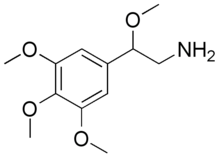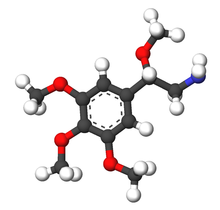BOM (psychedelic)

| |

| |
| Names | |
|---|---|
| IUPAC name
2-methoxy-2-(3,4,5-trimethoxyphenyl)ethanamine
| |
| Other names
3,4,5,beta-Tetramethoxyphenethylamine
2-(3,4,5,beta-Tetramethoxyphenyl)ethanamine | |
| Identifiers | |
3D model (JSmol)
|
|
| ChemSpider | |
CompTox Dashboard (EPA)
|
|
| |
| |
| Properties | |
| C12H19NO4 | |
| Molar mass | 241.28 g/mol |
Except where otherwise noted, data are given for materials in their standard state (at 25 °C [77 °F], 100 kPa).
| |
BOM, or 3,4,5,beta-tetramethoxyphenethylamine, is a lesser-known psychedelic drug. It is the beta-methoxy analog of Mescaline. BOM was first synthesized by Alexander Shulgin. In his book PiHKAL (Phenethylamines i Have Known And Loved), the minimum dosage is listed as 200 mg, and the duration unknown. BOM produces few to no effects.[1] Very little data exists about its pharmacological properties, metabolism, and toxicity.
See also
References
- ^ Shulgin, Alexander; Shulgin, Ann (September 1991). PiHKAL: A Chemical Love Story. Berkeley, California: Transform Press. ISBN 0-9630096-0-5. OCLC 25627628.
External links
